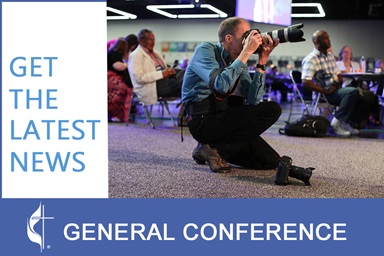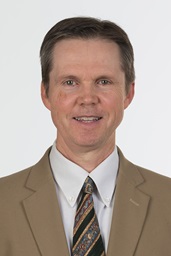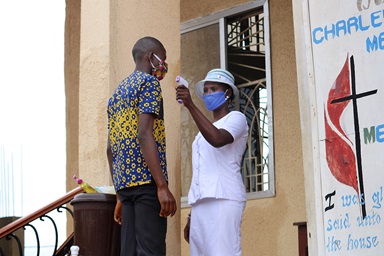Agnes Joseph, 2, lay pale in the children’s ward of United Methodist Mercy Hospital in Bo, suffering from malaria and typhoid fever. The little girl had anemia and a respiratory infection and was severely malnourished when she was brought to the hospital.
Her 17-year-old mother, Maria Joseph, weeped as medical staff battled for her daughter’s life. Later, as the child’s condition worsened, her family left the hospital to try native medicine. Doctors don’t know if she survived.
The hospital’s medical officer, Dr. Bockarie Kanneh, said daily malaria cases in the hospital are high and that the community health officer in charge of malaria sees more than 200 and sometimes as many as 300 additional malaria patients in the communities on each visit. During the dry season, he would only see about 100 patients per visit.
After Ebola
This is the fourth and final story in a series about the aftermath of Ebola in Sierra Leone and Liberia. Previous stories examined the lives of Ebola survivors and United Methodist healthcare in Liberia.
Kanneh says another worrying trend is that more patients are reporting with typhoid infection than malaria. However, typhoid is not difficult to treat. Kanneh said most of the people with typhoid were coming from areas that do not have treated water, which put them at high risk for typhoid.
Doctors cite a number of reasons for higher infection rates of malaria, including the normal annual peak during the rainy season. The 2014-15 Ebola outbreak also interrupted some prevention efforts, and people stopped coming to the hospital for fear of contracting Ebola.
A government-led mass distribution of insecticide-treated mosquito nets was disrupted in June 2014 by the deadliest Ebola outbreak in history. Malaria experts believe that using the treated nets can reduce malaria infection by 50 percent, so interruption of that program may be one reason hospitals are seeing more malaria patients.
The United Methodist Church supported the Sierra Leone government in the nationwide distribution of the long-lasting nets in 2014 through the denomination’s Imagine No Malaria Program.
The church bought 390,000 nets that were distributed in the Bo District and paid stipends for health volunteers involved in the process. Ebola interrupted the campaign just as the nets were being conveyed into the communities. The hang-up phase — when volunteers go into communities to ensure that families hang the nets — was abandoned because Ebola was spreading fast.
“Infection rates are high now just like in the previous seasons,” said Joseph Amara, the malaria contact person at United Methodist Mercy Hospital in Bo.
HOW you can help
Since June 2014, The United Methodist Church has been responding to the Ebola epidemic in West Africa and developing long-term support to health boards in Sierra Leone, Liberia and Cote d’Ivoire and other partners.
If you would like to give financially to support the goals of this long-term approach, please give to UMCOR Global Health, Advance #3021770. One hundred percent of your donation will help Global Ministries to work with local partners to strengthen healthcare capacities to confront this and other health challenges.
See news coverage
He says people focused all their attention on Ebola and forgot about malaria, HIV and other diseases that before Ebola were leading causes of death. Instead of prevention efforts bringing down the number of malaria cases, the malaria infection rate in the district is up. He says the high infection rate is evident in the communities he visits for outreach programs.
Dr. Gerald Young, medical superintendent of Bo Government Hospital, said malaria infection rates are high, though he has no figures to support that. Based on surveys, workshops and data from primary care, he believes the rates are gradually going down now.
“But Sierra Leone is a malaria endemic country. So we are still getting patients coming with malaria cases,” he said.
A report from the Sierra Leone Ministry of Health and Sanitation and UNICEF that assessed the impact of the Ebola outbreak on healthcare in Sierra Leone found that the number of children treated for malaria between October 2014 and January 2015 declined by 31 percent when compared to the previous year. That means about 27,200 children with malaria went untreated each month.
“There are two competing hypothesis to explain these trends: fewer malaria cases due to better prevention measures undertaken by families; fewer children being brought to facilities in the event of a fever for fear that the illness is confounded with Ebola,” the report said.
People stopped coming
Dr. Alhaji Turay, the district medical officer and head of the District Health Management Team, said now that Ebola has ended, people are returning to the health facilities for treatment.
“Now, we have revitalized all those activities. Malaria drugs are now available in the facilities. Community health workers are now being trained to do rapid diagnosis tests and treatment of malaria at (the) community level. That never happened during the outbreak of Ebola because there was need to minimize contact to break the Ebola transmission chain. These are all activities that were suspended during the outbreak. Malaria infection rate is up now because this is the peak season,” he said.
Malaria infection in Sierra Leone usually peaks in the rainy season between June and September when mosquitoes find a lot of stagnant water where they breed.
Dr. Omar Lamin, medical officer at United Methodist Kissy Hospital, said about 60 percent of the patients he sees each day are malaria cases.
Patients also are showing up in greater numbers with hepatitis and high blood pressure, healthcare officials report.
Lamin is more concerned about the number of hepatitis B cases he sees every day. He explained that hepatitis B is more infectious than HIV. He said contact with bodily fluids of an HIV patient is much less infectious than contact with the fluid of a Hepatitis B patient, since the Hepatitis B virus can penetrate the skin through touch.
“My concern now is to have all my staff vaccinated against hepatitis B,” Lamin said.
He has seen a rise in the number of hypertension cases, too, but cannot explain why that is happening.
“Even among young people, the cases are rising. I have seen a case as young as 17 years with a blood pressure of 200-plus. I am seeing hypertensive cases from the ages of 40 down to 15. For those in the age brackets of 40 and upward, that is expected or normal here in Sierra Leone. But the teenage infection rates are increasing and that is worrying. Even among ladies, the numbers are scary,” he said, adding that he had a particularly good drug for hypertension but has run out of it because of the number of patients.
Seek malaria treatment early
Lamin attributes malaria deaths in the hospitals to patients showing up late. And he said some of the family members take their loved ones to “quacks” in their communities.
“The quacks do wrong diagnoses and treatments and by the time patients show up they are ‘paper white’ and cannot respond to treatment,” he said.
He urges families to seek treatment early at the hospital.
“I tell them that when they have clothes to wear, they take them to the tailor and when they have to make chairs, they go to the carpenter. Equally, when you have your loved ones sick, take them to the hospital. If you take your loved ones to the quack, they gamble with the lives of your loved ones and they die,” Lamin said.
Steven Moinina heads the Physio-Therapy Unit at United Methodist Kissy Hospital. He said 60 percent of his patients are stroke victims, a result of hypertension. “The frontline cause of stroke in this country is hypertension,” Moinina said.
The unit treated 528 stroke patients in 2013 when there was no Ebola in the country. The numbers slumped during Ebola, when he saw just 234 in 2015. Now that the Ebola outbreak is over, Moinina expects to see more than 600 patients in 2016 because more patients with strokes are showing up every day. By mid-August, he had already seen 471 patients.
Patients often arrive with complications.
“For example, when a stroke patient is not well managed, they get stiff joints or become spastic,” he said.
Some are immobile, which Moinina said means a prolonged healing process because with stiff muscles, it becomes difficult for the patient to regain flexibility and eventually balance and strength. The patients also are screened for other infectious diseases.
“If they have any other medical conditions that warrant referral, then we refer the patient to our medical team down the hospital,” he said.
Patients are treated with exercise, traction and other therapies. Moinina said he has seen cases of total paralyses recover completely.
Jusu is communicator for The United Methodist Church in Sierra Leone.
Media contact: Vicki Brown, 615-742-5470 or [email protected].
Like what you're reading? Support the ministry of UM News! Your support ensures the latest denominational news, dynamic stories and informative articles will continue to connect our global community. Make a tax-deductible donation at ResourceUMC.org/GiveUMCom.




